 |
|
![]()
| ....Recollections of RAF Wyton in the 1960s |
| ... |
|
The
main road into camp looking towards the roundabout where the flag pole
is located opposite SHQ. The main Guardroom was on the left behind the
camera. Straight ahead just over the other side of the roundabout on
the right hand side is where the NAFFI grocery shop was. Further down
on the left was Station Sick Quarters. Behind the Naffi shop was a green
and across the green was Devon Road (AMQ). Turning right at the roundabout
led to Cornwall Road and the Airman's married quarters. On the right
hand side of Cornwall Road was the Families Club.
|
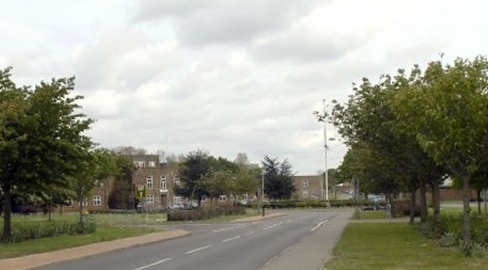 |
Turning left at the roundabout the road led to the NAFF! and the Junior
ranks club on the right handside of the road. On the left the first
building was the hobbies and education centre. This was where the amongst
other things the Youth Club was located. The other buildings on the
left hand side of the road were all Airman's accomodation blocks. The
road going off to the left led to the Airmans mess where Connie Coppin's
newspaper kiosk was located. There is also a road going off to the right
(out of shot) that led to the Officers mess and to Officers married
quarters.
|
||
|
RAF
Wyton the main road into camp (Pathfinder Way)
|
||||
| ...RAF Wyton and the Cold War |
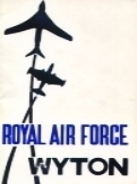 |
"You are now
at the United Kingdom Strategic Reconnaissance Base which is allied to
the 'V' Force of Bomber Command - Britain's major deterrent against global
war". That
is how the Foreword page described RAF Wyton in the station handbook back
in 1963, and that was indeed the case, and for many of us it was also
the place where we lived, because that was what our dad's job was: defending
the realm. The days of the 'V' bomber force, serving to provide the United
Kingdom's major deterrent against global war, was however, coming to an
end. In 1962 Prime minister Harold Macmillan had been in talks with American
President John F Kennedy, and, Kennedy had insisted that Britain should
abandon it's airborne nuclear capability in favour of the submarine based
Polaris delivery system. (See the Daily Mirror headline on the left).
What this meant of course, was that the Royal Navy would in future assume
the mantle of being the nations major deterrent. Wyton would continue
to carry out it's it's very important reconnaissance role for many years
to come, but the strategic deterrent element would be transferred from
the air to under the sea |
|
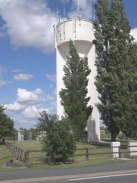 |
Pictured
left. The first thing that you would see when you arrived at RAF Wyton.
The Wyton water tower. It did not matter from which direction you approached
RAF Wyton the water tower was clearly visible. Back in the 1960s the
tower was not hidden behind the Normandy poplar trees as it is today.
Inevitabley, in this age of mass multi media electronic comunication
the tower is now festooned with a vast array of mobile phone aerials.
The picture on the right shows a Whippet coach in 1965 about to depart
from Kings Cross in London for RAF Wyton probably on a Sunday evening.
The passengers would have alighted at the water tower. The alternative
for getting back to camp would have been by train from Kings Cross to
Huntingdon, and then hiring a taxi. The bus in the picture might well
have been back at Wyton the following morning to do the Ramsey Abbey
School run.
|
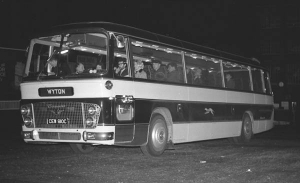 |
||
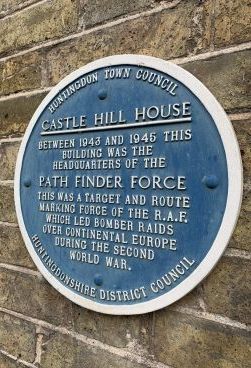 |
In 1943 RAF Wyton became home to 156 pathfinder squadron. The actual Pathfinder Force General Headquarters was located in Huntingdon at Castle Hill House. On the outbreak of WW2 RAF Wyton based Blenheims were some of the first RAF aircraft to attack Germany. The plaque reads: "Between 1943 and 1945 this building was the Headquaters of the Pathfinder Force. This was the target and route marking force of the RAF which led bomber raids over continental Europe during the second world war" |
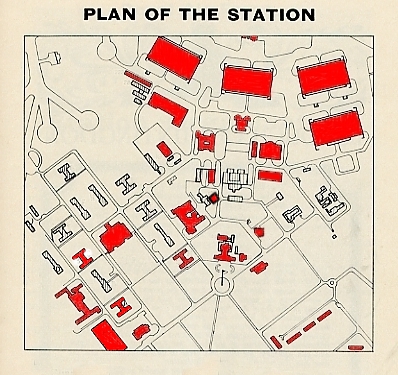
|
||
| Pathfinders memoriall plaque on the wall of Castle Hill House in Huntingdon | This plan of the the station is from the Wyton Hand book. By running your mouse cursor over the areas highlighted in red you will be able to identify the locations of buildings and some of facilities at RAF Wyton in the 1960's. This plan is limited to the central area of the base and does not extend to show areas such as the main married quarters complex, the officers mess or the Astra cinema for example |
|
...The
Wyton Eye magazine
|
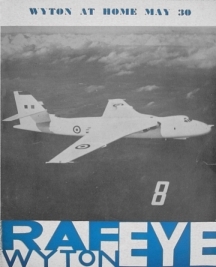 |
|
The
Wyton Eye magazine was published every month by the station education
section. The magazine was distributed through out the Station and was
free of charge. All personel were invited to contribute to the the magazine.
Anyone interested in doing so would have submitted their contribution
to the senior education officer. The magazine featured articles on various
station activities and social events, sporting fixtures, and results.
This particular edition (according to the front cover) is featuring and
giving details of the Wyton at home day on May 30th. The year was almost
certainly 1964, because the 30th of May in 1964 fell on a Saturday, and
"At home" or open days were always held on a Saturday. Historically
open days were associated with the Battle of Britian which is normally
celebrated in the month of September. It is of course possible that this
was a families only home day, and that it was not open to the general
public. |
|
|
...Station
security in the 1960s
|
 |
This what the Wyton Hand Book had to say about security
matters."In peace and war continous watchfulness is essential for
effective security and all ranks have a duty to report any breach of
security. In particular all strangers should be viewed at all times
with suspicion until YOU have checked their credentials. REMEMBER:
SECURITY IS YOUR BUSINESS, KEEP YOUR BUSINESS SECURE Basically,
if a building does not concern you it is out of bounds unless you are
required to enter it on duty. When entering Security Areas your identity
tag must always be worn. Bounds apply equally to technical and domestic
buildings, including messes and quarters".
|
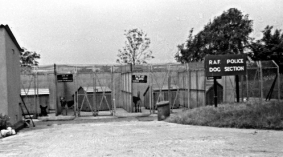 |
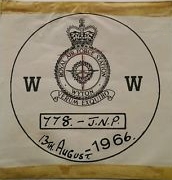 |
|
Despite
what the Wyton Hand Book said, surprisingly in practice, the reality
was, that although in the early 1960's it was at the height of the "cold
war" security was quite lax. There was always an RAF policeman
on duty outside the main guard room, but in the early 1960's access
to RAF Wyton was unrestricted. Passes and proof of identity were not
required to be shown. There was a single pole barrier, but it was always
in the raised position. Visitors were free to come and go more or less
as they pleased. Although
airman's married quarters could only be be accessed via the main gate
entrance, entry to officers married quarters was by a direct and unmonitored
entrance from the B1090 St Ives to Abbots Ripton road (Sawtry Way).
By the mid sixties however, security arrangements had been revised.
|
|||
|
Vehicle
pass
|
RAF
Wyton Police Flight 1959. Click image to enlarge
|
|
...The
aircraft based at RAF Wyton in the 1960s
|
|
There
were three squadrons operating from RAF Wyton in the sixties. 543 ,
58, and 51. 543 flew Valiants and Victors. 58 flew Canberra PR9's. 51
squadron was equipped with a highly unlikely assortment of aircraft.
Canberras, Comets, and Hastings. All three squadrons were involved with
reconnaissance and surveillance operations, but 51 squadron probably
had the most secretive and interesting tasks. Illustrated below are
the aircraft types that were operated in the sixties. In addition there
was also Comms flight that operated Devon and Ansons. To read more about
51 Squadrons activities in the cold war click on the External Links
button at the bottom of the page
|
| The aircraft in service with 51 squadron in the 1960s |
|
51 Squadron |
|
|
 |
|
The aircraft in service with 543 Squadron in the 1960s |
|
543 Squadron |
|
|
| The aircraft in service with 58 Squadron in the 1960s |
|
58 Squadron |
|
|
| The aircraft in service with comms flight in the 1960s |
|
Comms flight |
 |
|
| ...RAF Wyton at work |
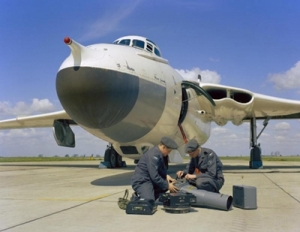 |
The
Vickers Valiant was the first of the "V" bombers. However,
due to the discovery of severe metal fatigue in the main wing spar the
Valiants were all withdrawn from RAF Service in early 1965. Repair and
rectification was deemed to be uneconomic. The 543 Squadron Valiants
were replaced by Handley Page Victors in May 1965.You can read more
in greater detail about this and the Valiants photo reconnaissance role
fitment by clicking the external links button at the bottom of
the page. The 58 Squadron Canberra WH796 pictured here on the right
is reported to have been preserved by the Hemswell Aviation Society
museum. (nose section only)
|
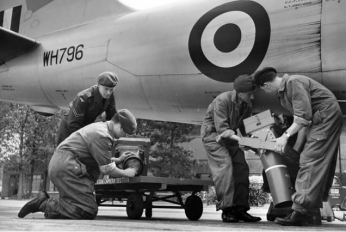 |
||
|
Preparing
a camera for a 543 Squadron Valiant
|
Loading
cameras into a 58 Squadron Canberra
|
|||
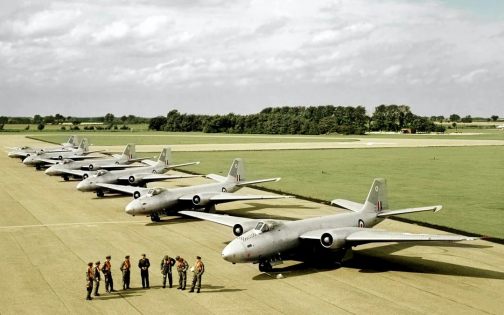 |
|
58
Squadron Camberra PR9s and crews in 1960
|
| ...The fire section |
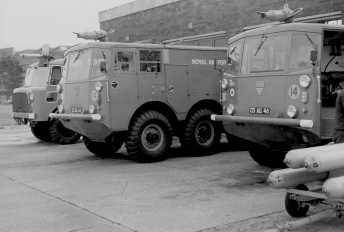 |
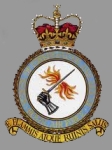 |
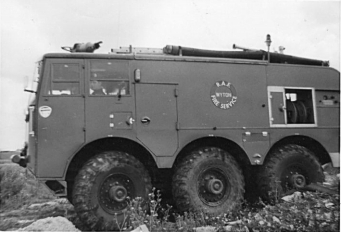 |
||
|
RAF
Wyton Fire Section
|
RAF
Fire Service Crest
|
Wyton
Fire Section Alvis crash tender.
|
|
Four of the guys from RAF Wyton fire section in the 1960's. They are
from left to right: Bob Marshall, Ted Bailey, John Irwin, and
Mick Donaghue. I would like to express my thanks to John who kindly
submitted this photograph and for identifying the people in it
|
Bob
Marshall was the lead singer in RAF Wytons rock'n'roll band The Drifting
Strangers. I remember that Bob used to ride a Triumph 21 motorcycle like
the one pictured below. You can see Bob with the Drifting Strangers
here |
||
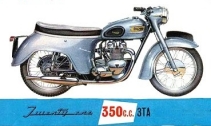 |
|||
|
Click
on the image to see more RAF Wyton Fire Section pictures
|
|||
| The 1960s Station Commanders | The 1969 Daily Mail transatlantic air racee |
 Group
Captain
Group
CaptainE.G.Jones |
There
were four different station commanders at RAF Wyton during the 1960s.
The first was: Group Captain E.G. Jones (who had assumed command
of RAF Wyton in 1957) and was the Commanding Officer until 1961. He
was then succeeded by Group Captain P.H.G. Wintle (1961- 63).
Followed by Group Captain G.Young (1963 - 69), and finally Group
Captain A.G. Steele who took command in 1969.
|
In
1969. The Daily Mail organized a transatlantic air race, to commemorate
the 50th anniversary of the first transatlantic air crossing by Alcock
and Brown in June of 1919, and RAF Wyton was part of it. Shown here
is a letter carried by a Victor belonging to 543 squadron. The letter
was taken from Wyton to Wisley (BAC aircraft factory airfield) from
where the Victor and a Royal Navy Phantom flew to a New York Naval Air
station..
For a full size view click on the image. For the full story of the race.
543 Squadron and the air race click on the External Links button
below.
|
| And not a lot of people know this |
| A Bristol Blenheim of No. 139 Sqn, Wyton, carried out the RAF's first operational sortie of the the second world war - photographic reconnaissance of the German naval base of Wilhelmshaven. |
Please choose